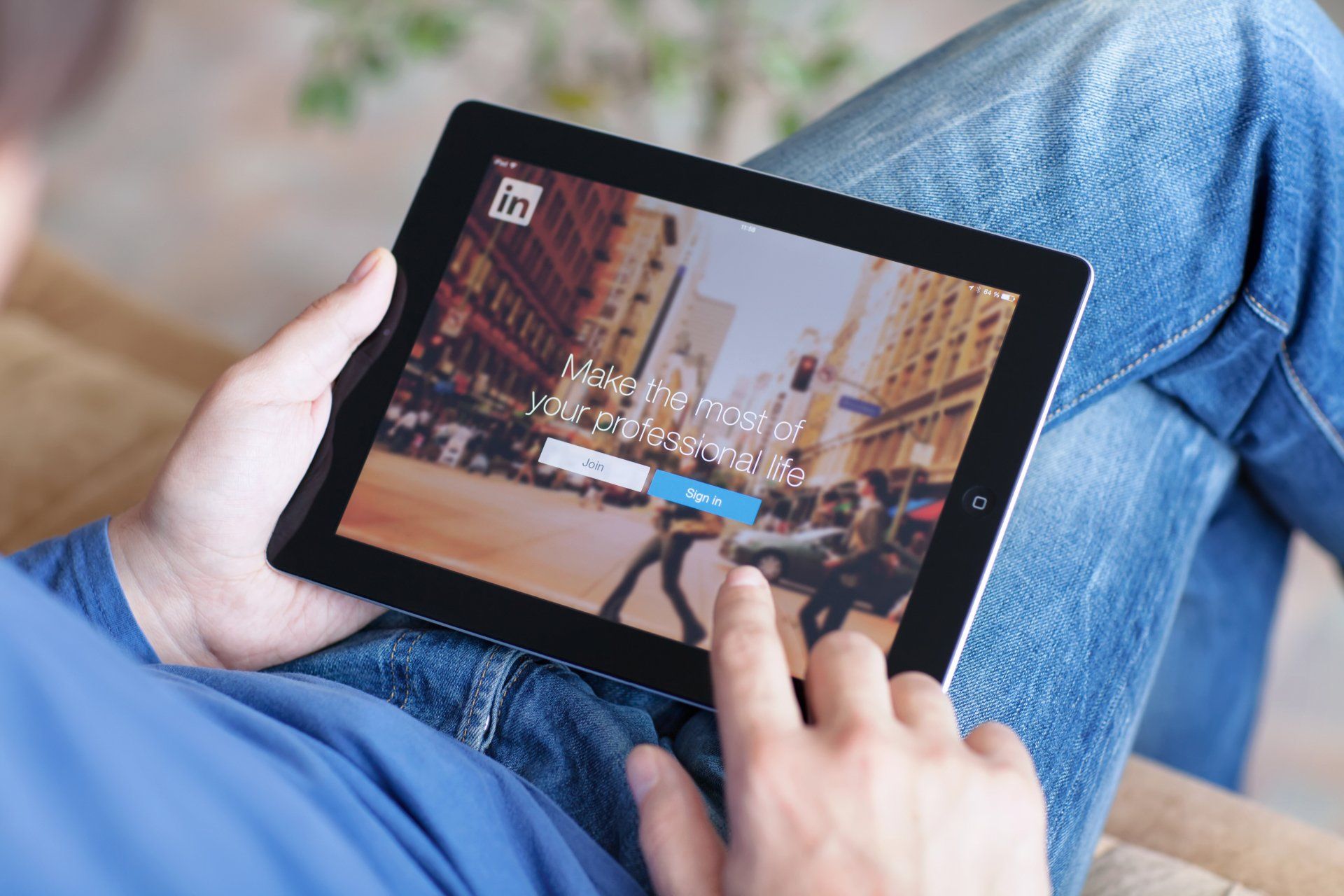How to Increase Sales Using LinkedIn
Cotswold Web • 28 May 2020
If you think LinkedIn is just somewhere to search for a new job or new employees, you are missing a trick. With over 500 million members in 200 countries and geared specifically towards professionals, it is also a way of linking you with a huge number of potential customers who could be looking for your brand . Used effectively, LinkedIn can help you grow your sales.
But how do you do that?
Here’s our top tips for increasing your sales using LinkedIn…

A really good profile
Your profile is the first thing a visitor to LinkedIn will see. And they will decide within seconds of looking at it whether they want to connect and do business with you.
Your photo should look both professional and friendly and your profile summary should be clear.
You’ve got 2000 characters to really sell yourself and your business. You should add some personality, tell your career story and inspire action from your connections. Make sure you make it work!
Connect, connect, connect
You should send up to 150 personalised connection requests every day
to your target audience to build your network. Connection requests should always include a short message to introduce yourself.
Start with people you know, colleagues and former colleagues. Then use the search page to find people in related industries or your local area, who you could potentially do business with.
- The Grow Your Network page will help you connect with people already in your email address book
- The My Network page will display pending invitations from people wanting to connect with you
- The People You May Know feature will suggest other people you may want to connect with
Not only is every connection, known as 1st degree connections, a potential customer, they are also a way to meet other potential connections – 2nd degree connections (people who are connected to your connections).
You should aim for more than 500 connections in total. Having over 500 connections means you will appear in more searches.
LinkedIn will just show you as having 500+ connections – so it doesn’t matter if you have 501 or 4000, you will appear the same to connections and potential connections. If you have less than 500 connections – LinkedIn will show your connections as the exact number. If that number is low, people are less likely to see you as a valuable person to connect with.
Follow up
Once someone has accepted your connection request, send them a quick message to thank them for accepting your invitation. You should also give a brief introduction to yourself, without getting into sales talk.
This introduction will help your connection feel that they are getting to know you, which will mean in turn that they are more likely to do business with you in future.
Don’t be afraid to get in touch again at a later date if you feel you can offer something of value to your connection eg if you have seen a post from them on a particular subject that you can help with. But make sure your messages can’t be seen as spam. LinkedIn is about building a professional relationship, so don’t be tempted to send sales information or anything which could be viewed as irrelevant.
Keep publishing posts
Having grown your LinkedIn network, you want to keep your connections interested in you, your brand and what you have to say. So it is important to publish posts regularly to earn their trust, with a view to connections ultimately becoming customers.
Make your posts a mix of your own original articles – either written specifically for LinkedIn or new posts from your blog (include a link back to your website), articles from other businesses or business leaders, and news articles. You can also include relevant reports, presentations or videos. Having a variety of types of post is more attractive to LinkedIn followers than just relying on one sort of post.
Have a look at other posts which are popular and receive lots of shares and engagement. Try to share something similar, without actually copying them.
But beware of posting for the sake of posting. If you share everything that pops into your mind, you risk your valuable posts getting lost in your own ‘noise’.
You should aim to post between twice a week and once a day – on weekdays only. There is no advantage to posting more than once a day.
Make sure you engage with your audience when they comment on your posts – and take time to comment on your connections’ posts too. As ever, it’s important to keep your comments relevant to ensure they add value – just saying ‘Great post’ is less relevant than saying nothing at all.
Use LinkedIn Groups
LinkedIn Groups are a place for professionals either in the same industry or with similar interests to interact, ask for advice, share experiences and build valuable connections. There are groups on LinkedIn covering a whole range of industries.
You can search and request to join particular groups. Group managers may ask for additional information to make sure you meet their criteria. This means you can feel confident about the quality of a particular group.
Make sure you are active in a group and that you ask and answer questions, as well as providing the group with any relevant updates.
Again, it is important to steer clear of offering information which is blatantly sales-related. Instead, by showing yourself to be a helpful and supportive group member, you will see sales rise organically.
Export your data
You can download all of your data from LinkedIn, including everything from details of your connections to how you interact with ads, who has endorsed you and the results of search queries.
Although downloading the data can be time consuming, it is useful so that you have a back-up in case there is a problem with your account.
Most importantly, downloading data also means you can share information with colleagues, who can make contact with your connections and help you grow your business. (Although LinkedIn’s most recent privacy update does mean that not everyone gives permission for contacts to download their email addresses.)
Use Facebook
Facebook ads are incredibly cost-effective, and Facebook is the world’s number one social media site, with 1.73 billion users accessing it every day worldwide in 2020. There are nearly 45 million Facebook users in the UK alone.
So exporting your LinkedIn connections and retargeting them on Facebook can really drive leads and engagement for your business.
When you have your connections’ email addresses from exporting your LinkedIn data, you can upload them to Facebook as a custom audience. Then you can start running ads, including video ads, for your new custom audience. You should give your audience the option to connect to your website with a ‘Find out more’ button.
If you are already sharing interesting and engaging content on LinkedIn, your connections will trust you to do the same on Facebook.
In this way, Facebook has the potential to become a really valuable element of your marketing.
Keep going!
Using LinkedIn as a way of increasing sales might seem like a lot of work initially, but once you’ve put that work in, it will become less time-consuming.
Make sure you keep up the momentum of publishing posts, engaging in groups and building your connections over time. Sticking with LinkedIn in the long-term will help you get to know your connections and build trust with them, which will ultimately help you boost your sales.
Increasing sales through LinkedIn won’t happen overnight.
It is a long-term strategy, but if you put the effort in, it is a way of connecting with the right people and building relationships - with the aim of these people becoming regular customers and supporters of your brand.
More Posts.

In today's digital landscape, effective content marketing can be the key differentiator for small businesses striving to stand out. As consumers increasingly turn to online platforms for information, brands must engage their audiences through valuable content that resonates with their needs. Understanding the nuances of content marketing is crucial; it encompasses various strategies designed to attract, inform, and delight customers while ultimately driving sales. From developing engaging customer personas to measuring success through specific metrics, small businesses have an incredible opportunity to refine their marketing approach. This article explores eight proven strategies that can lead to content marketing success for small businesses, equipping you with the tools necessary to create impactful and sustainable marketing efforts. 1. Understanding the Importance of Content Marketing Content marketing is vital for small businesses. It helps connect them with their target audience, builds brand awareness, and drives organic traffic. A well thought out content marketing strategy lets small businesses compete with larger companies by using cost effective methods. Regularly sharing valuable content can position a business as an expert in its field. This fosters trust and encourages potential customers to seek their services. Documenting your content strategy also increases the chances of seeing your marketing efforts as effective, allowing a higher allocation of budget toward content marketing. Creating a diverse range of content types is key. Here are some content formats to consider: Blog Posts Social Media Posts Email Marketing Visual Content Developing a strategic content plan helps business owners carve out unique market spaces. Establishing clear business goals and using tools like Google Analytics to gauge conversion rates can refine your approach. Below is a quick checklist for effective content marketing: Know your target audience Set SMART goals Use a content calendar Perform a content audit By focusing on these elements, small businesses can enhance their content marketing efforts and achieve growth. 2. Developing Customer Personas for Targeted Engagement To create targeted content, small business owners should develop detailed buyer personas. These personas are fictional versions of ideal customers, including demographic and psychographic details. Tools like Google Analytics and social media insights provide valuable data to shape these personas, making them more accurate. Understanding your target audience through buyer personas is key. It allows content marketers to tailor pieces of content that address specific needs and challenges. This approach boosts engagement and builds trust with potential customers. It is often necessary to have multiple personas to cater to various products, services, or customer segments. Each persona reflects different motivations and interactions with your brand at various stages of the customer journey. Here's how you can develop them: Collect Data: Use surveys, Google Analytics, and social media insights. Analyse: Determine the needs, interests, and behaviours of your audience. Create Multiple Personas: Define different segments based on your findings. Tailor Content: Use the personas to guide your content marketing efforts. Effective personas lead to a successful content marketing strategy, enhancing your business goals with every piece of content created. 3. Crafting a Comprehensive Content Plan Creating a successful content plan is key for small business owners. It acts as a guide to align all your content marketing efforts with your business goals. Here’s how you can craft a comprehensive content plan: Identify Key Topic Areas: Focus on subjects relevant to your target audience. This ensures you create valuable content that speaks directly to potential customers. Choose Content Types: Use a mix of blog posts, infographics, and videos. Different content formats can help engage various segments of your market. Plan Distribution Channels: Decide where to share your content. Consider social media posts, email marketing, and your website for maximum reach. Set Calls to Action: Encourage your audience to take the next step. This could be signing up for a newsletter or visiting a product page. Utilise a Content Calendar: This keeps your content marketing strategy organised and consistent, minimising missed opportunities. Analyse Metrics: Use Google Analytics to track conversion rates, engagement, and content performance. Including these elements in your content plan aligns with the fact that structured strategies significantly boost success rates. Regular content audits refine this strategy further, ensuring continued engagement and growth .

Heading 1 Artificial intelligence (AI) has had a huge impact in many areas of life and SEO is no exception. While it has made online searches easier for consumers, keeping up with it and staying ahead as a business can be challenging. As Google integrates advanced AI into its search results, businesses must rethink their SEO strategies. Understanding the future of SEO in the context of AI is essential to appear high on search rankings and remain competitive. Traditionally, search engine optimisation (SEO) has relied largely on keyword optimisation and link building. If you sell garden products, you would make sure the phrase ‘garden products’ was used frequently throughout your website. You would also look to get some links back to your site from other websites – maybe other businesses in your local area or in a complementary sector. These traditional SEO methods are becoming less effective. AI means search engines like Google and Bing have become better at understanding the intent behind a search, through machine learning algorithms analysing huge quantities of data, as well as natural language processing. Natural language processing doesn’t just understand the words in a query, it understands the context and intent behind it. AI can even understand synonyms, slang and regional variation in language! When someone searches for something online, AI can analyse, interpret and predict their behaviour. So businesses have to adapt their SEO strategies to changing algorithms to stay competitive. You need to have a deeper understanding of your target audience and produce content which meets their needs and answers their queries. It is about providing the best answer to the questions your audience is asking, because AI algorithms are skilled at recognising content which meets the search intent of users and provides value. This means that content which is designed to meet specific needs, answer questions and provide the solutions to problems is more likely to rank higher in searches. AI algorithms will prioritise content which resonates with users on a human level – with every paragraph adding more value and depth. This aligns with AI’s preference for content which engages and informs – and also helps build a stronger connection with your target audience. In addition, AI is making voice searches (e.g. Alexa) much more effective. Voice searches tend to use more words than online searches e.g. ‘find me healthy snacks for pre-school children’ rather than just typing ‘healthy snacks’ into Google with no context. This aspect of AI will continue to grow in importance and become even more widely used.






